Vilasi G. Hamiltonian Dynamics
Подождите немного. Документ загружается.


324
KdV
Equation
1
2
B
=
-.laxxx
-
U(Z,
t)a,
-
-u~(z,
t)
.
Let
us
consider the eigenvalue problem
L$
=
k2$
,
which will have
as
solutions
fie states,
corresponding to
k2
>
0,
represented by waves
+O(x,
k,
t),
whose asymptotic behavior is given by
where
are the unknown
tra~sm~ss~on coeficient
and the
reflection coefficient,
respect ivefy
;
bound states,
corresponding
to
k2
<
0,
represented by eigenfunctions
$:(x,kn),
with
ki
=
-x$
(or
better,
kn
=
iXn,
xn
>
0),
whose
asymptotic behavior
is
given by
N
$n(Z,
ixn,t)
x4--00
exPlxn4
1
$3.1
ixn,
t)
zf;bo
Cn(Xn7
t>
.XP[-Xn.I
1
where the coefficients
ci(xn,
t)
are the unknown
normalization con-
stants.
The set
s
=
{xn, cn(xn,
t.),
R(k,
t)
1
Vk
E
Ill}
is
the
set
of
scattering data
which can be determined by the asymptotic be-
havior
of
the operator
B

Conservation
Laws
325
Indeed, the equation
$=B$,
400
=
B,&J
9
given in
Eq.
(12.19),
will be true also ~ymptotically
so
that we
can
write
e
for
bound
states
&(xnrt)
@XP[-Xn4
=
4X%n(Xn,
t)
exP[-Xn4
r
4Xn,
t)
=
&xn>
exp[4x3ntI
;
which
is
trivially integrated to
for
fTee
states
C(k,
t)e-+kc
=
-4ik3c(k,
t)e-ik”,
C-
(k,
t)e-ik”
+
&+{kt
t)eikx
=
-4ik3fC- (k,
t)e-ikx
-
C+
(k,
t)e’ik”2]
,
which gives
C(k,
t)
=
-4ik3C(k,
t),
C-(k,
t)
=
-4ik3C-(k,
t)
,
C+(k,
t)
=
4ik3C+(k,
t)
,
and then,
T(k,
t)
=
TO(k),
R(k,
t)
=
Ro(k)
=p(8ik3t]
.
At this point, we know the time evolution of scattering data when the
“potential” changes according to the KdV equation. We also know that the
number of bound
states
does not change
in
time and
is
determined
by
the initial condition
UO(Z).
In
our
time-dependent case, the
GLM
formula (see Appendix
G)
must be
written in the form
CQ
A(z,
y,
t)
+
F(z
+
y,
t)
+
1
A(z,
z,
t)F(z
+
y,
t)dz
=
0,
X

326
Kd
V
Equation
and the solution
of
KdV
will
be given by
d
dx
U(Z,
t)
=
-~-A(x,
Z,
t)
.
The
o~e-so~~~o~
so~~~~o~~
Let us consider
a
tr~n~p~~nt ~otent~u~
i.e. an
initial condition
UO(Z),
such
that the direct scattering problem gives
Ro(k)
=
0.
Suppose, moreover, that there exists
only
one bound state, with eigenvalue
-x2
and normalization constant
CO.
The kernel
F
of
GLM will be given by
~(2,
t)
=
c;e4x3t-xz
,
so
that
GLM
gives
or
Since
this kernel
is
separable, we can try to
find
a
solution
of the following
form:
so
that the equation simplifies to
and algebraically,
we
obtain
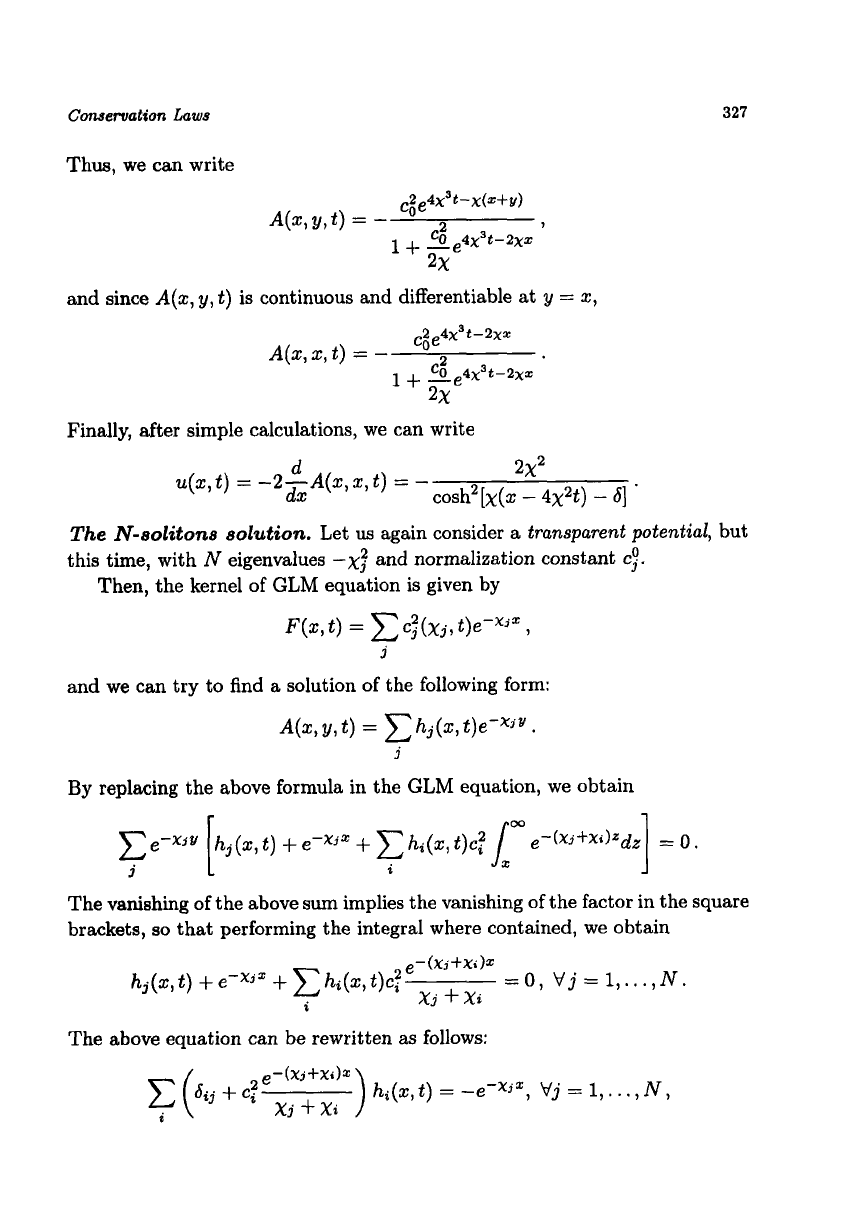
Conseruation
Laws
Thus, we can write
2
4x%-x(xSy)
COe
A(x,y,t)
=
-
2
7
co
4x3t-2xx
2%
1+-e
and
since
A(%,
y,
t)
is continuous and differentiable at
y
=
z,
C$e4X9t
-2xx
1
+
Cge4x3t-2xx
A(z,~,t)
=
-
2
2X
Finally, after simple calculations, we can write
327
d
2X2
U(Z,
t)
=
-2--A(z,
Z,
t)
=
-
dx
cosh2[x(x
-
4x2t)
-
61
'
The
N-solitons
solution.
Let
us
again consider a
transparent potential,
but
this time, with
N
eigenvalues
-$
and normalization constant
c;.
Then, the kernel
of
GLM equation is given by
F(Z,
t)
=
C
ci(xjl
t)e-xjz
,
j
and we can try to find a solution of the following form:
A(z,
y,
t)
=
hj(x,
t)e-xjY
.
j
By
replacing the above formula in the GLM equation, we obtain
The vanishing
of
the above
sum
implies the vanishing
of
the factor in the square
brackets,
so
that performing the integral where contained, we obtain
The above equation can be rewritten as follows:
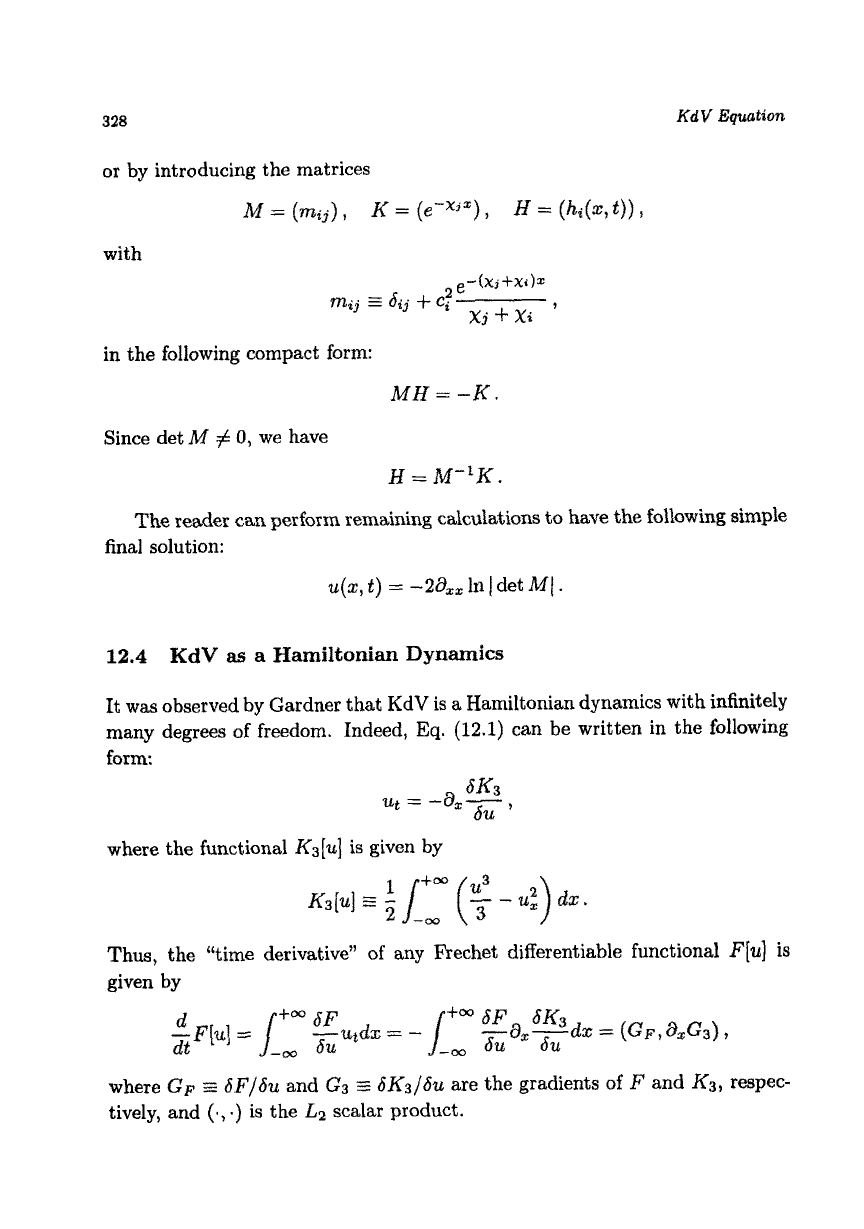
328
Kd
V
Equation
or
by
introducing the matrices
M
=
(mi$)
,
K
=
(e-xj"),
H
=
(~~(~,t)),
with
in the following compact form:
MH=--K.
Since det
M
#
0,
we have
H=M-lK.
The
reader
can
perform
remaining calculations
to
have the
following
simple
final solution:
u(x, t)
=
-2aX.
In
1
det
MI.
12.4
KdV
as
a
Hamiltonian
Dynamics
It
was
observed by Gardner that KdV is a Hamiltonian dynamics with infinitely
many degrees of freedom. Indeed,
Eq.
(12.1)
can be written in the following
form.
6K3
ut
=
-ax-
du
'
where the functional
K3[21]
is
given
by
Thus,
the "time derivative"
of
any Fkechet differentiable functional
F[u]
is
given by
where
GF
I=
SF/Gu
and
G3
3
6K3/6u
are the gradients
of
F
and
KJ,
respec-
tively, and
(0,
.)
is the
Lz
scalar product.

KdV
ap
a
Hamiltonian
Dynamics
329
It
is
easy to check that, for any two Frechet differentiable functional
F
and
F',
the bracket
on the chosen class of functions, is antisymmetric. Moreover, it satisfies the
Jacobi identity and is a derivation on the associative product
of
functionals.
Thus, we
can
conclude that KdV is
a
Poisson dynamics whose Poisson bivector
field
A
has components, in the formal basis
e(z)
=
6/6u(z),
given by the
operator
8,.
The operator
ax
has
a
kernel given by constants
c
E
IR,
so
that it does not
have
an
inverse, and KdV
is
not strictly
a
Hamiltonian dynamics.
However, on the quotient manifold, namely
M,
KdV is
a
Hamiltonian
dynamics; indeed, the manifold
M
can be endowed the symplectic structure
qu]
=
s'"
dx
[;
dY[6+)
A
WY)]
9
-"
which having constant coefficients, is trivially closed.
structed by means
of
Lenard's sequence
(12.11),
a
-Gn+1
=
EkGn
1
dX
Moreover, it
is
easy to show that functionals
Kn,
whose gradients are con-
n
=
1,2,3,
are pairwise in involution. Indeed,
Thus,
if
n
<
m,
an index
k
can be found such that
with
A,
one
of
the two antisymmetric operators
8,
or
Ek,
so
that
A
further important step on the study of KdV,
is
represented by the fol-
lowing result by Faddeev and Zakharo~.'~
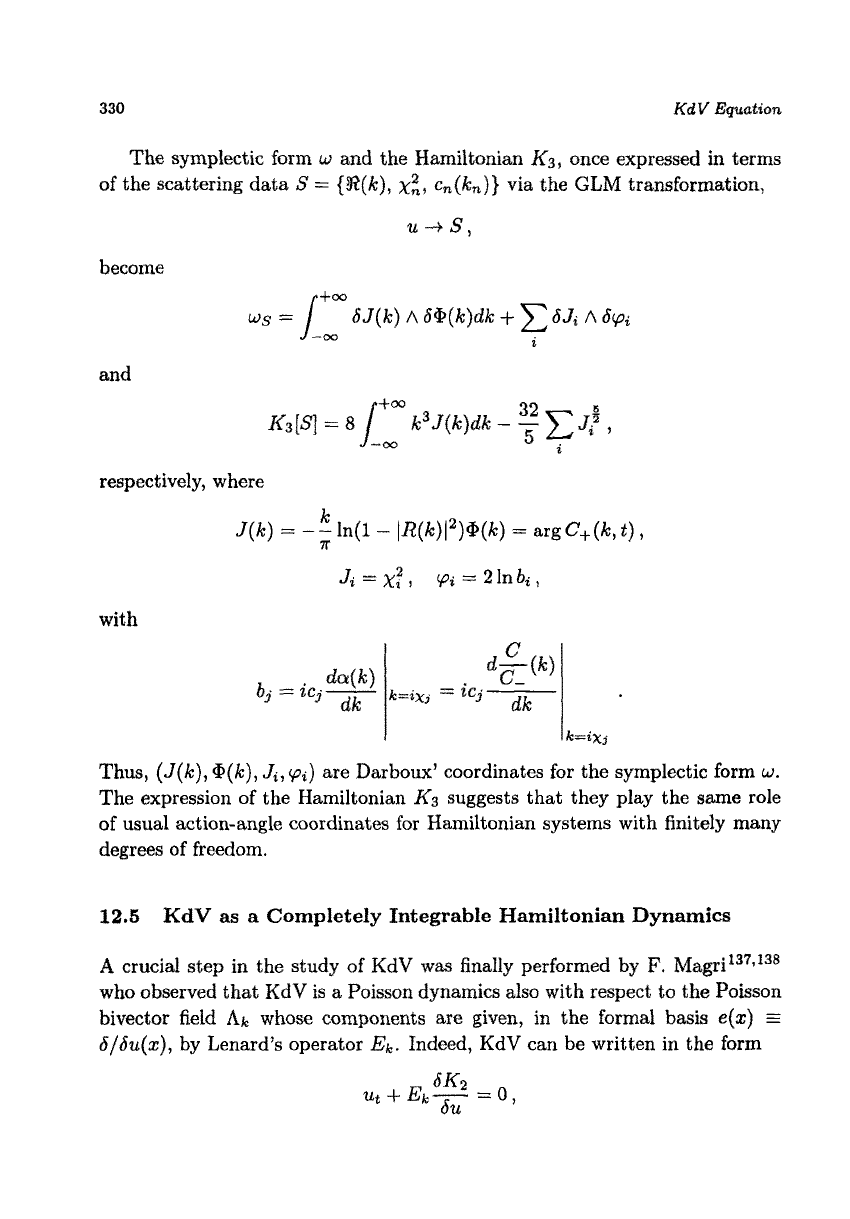
330
Kd
V
EquatQopt,
The sympIe~tic form
w
and the ~~miltonian
&,
once expressed in terms
of the scattering data
S
=
{R(k),
xz,
cn(k,))
via the GLM transformation,
U3S,
become
+w
GJ(k)
A
S@(k)dk
+
C
6Ja
A
6~;
i
and
respectively, where
k
J(k)
=
--ln(1
-
lR(h)(2)@(k)
=
argC+(k,t),
7r
Ji
=
xf
,
pi
=
Zlnbi,
with
I
Ik=iXj
Thus,
(J(k),
@(k),
Ji,
cpi)
are Darboux’ coordinates for the symplectic form
w.
The expression
of
the Hamiltonian
K3
suggests that they play the
same
role
of usual action-angle coordinates for Hamiltonian systems with finitely many
degrees of freedom.
12.5
KdV
as
a Completely Integrable Hamiltonian Dynamics
A
crucial step in the study
of
KdV was finaliy performed by
F.
Magri137~138
who observed that KdV
is
a
Poisson dynamics also with respect to the Poisson
bivector field
Ak
whose
components
are
given, in the formal
basis
e(z)
=
b/Su(z),
by Lenard’s operator
&.
Indeed, KdV can be written
in
the
form
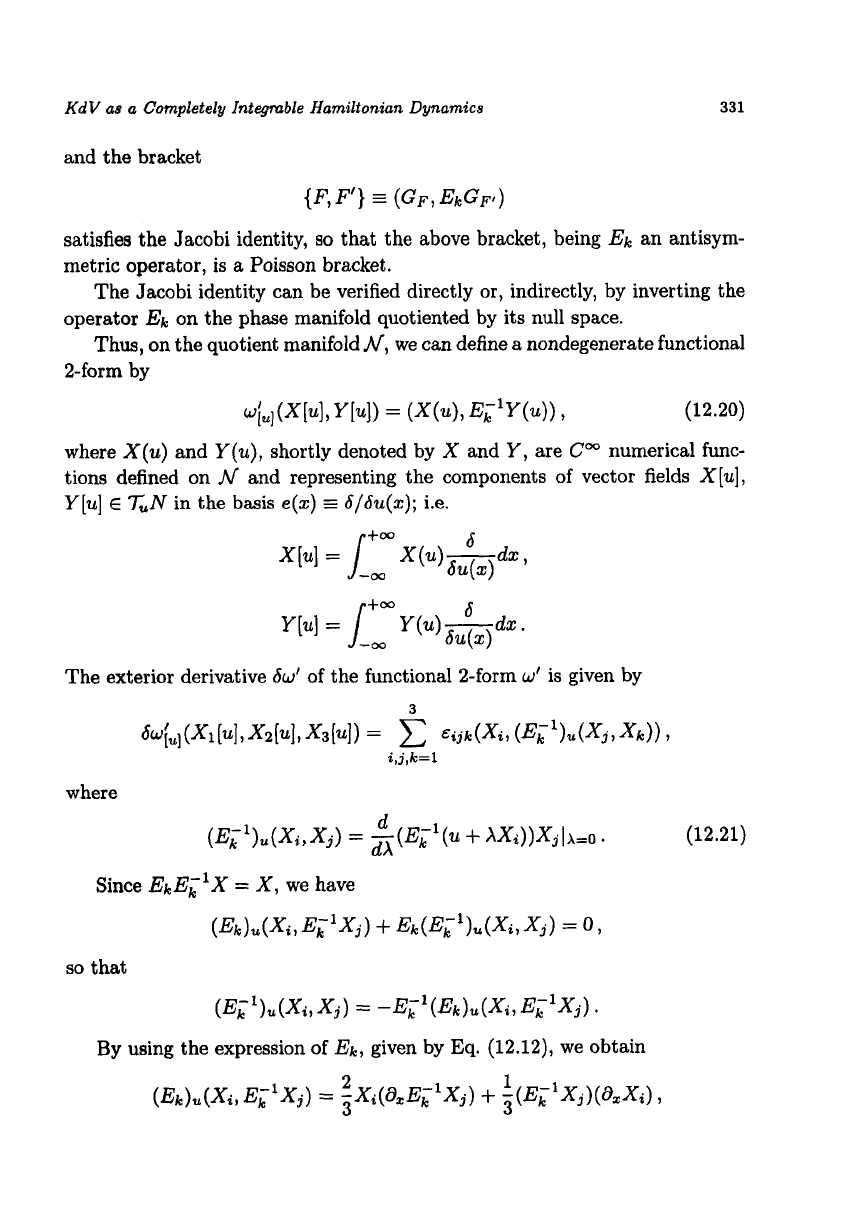
KdV
as
a
Completely Integrable Hamiltonian Dynamics
331
and the bracket
{F,
F'}
3
(GF,
E~GF~)
satisfies the Jacobi identity,
so
that the above bracket, being
Ek
an antisym-
metric operator,
is
a
Poisson bracket.
The Jacobi identity can be verified directly or, indirectly, by inverting the
operator
Ek
on the phase manifold quotiented by its null space.
Thus, on the quotient manifold
N,
we can define
a
nondegenerate functional
2-form by
wju](X[UI,
YI.1)
=
(X('LL),
Jw(4)
1
(12.20)
where
X(u)
and
Y(u),
shortly denoted by
X
and
Y,
are
C""
numerical func-
tions defined on
N
and representing the components
of
vector fields
X[U],
Y[u]
E
TUN
in the
basis
e(z)
=
6/6u(z);
i.e.
d
X(U)-dz,
+m
WX)
s
+m
Y(u)--dx.
Y[UI
=
s_,
a+>
The exterior derivative
6w'
of
the functional 2-form
w'
is given by
3
awjUi(Xi[~],Xz[~],X3[~])
=
C
~ijrc(Xi,
(Eil)u(Xj,Xk)),
i,
j,
k=l
where
d-
dX
(E~l)u(X~,Xj)
=
-(Ek
'(u
+
XXi))Xjl~=o.
Since
EkEi'X
=
X,
we have
(Ek)u(xi)
EF'Xj)
+
Ek(Zr')u(Xai
xj)
=
0
7
so
that
(E;')u(xi,Xj)
=
-E;l(E&(Xi,
EL'Xj).
(Ek)u(xi, E,-'Xj)
=
-Xi(&E;lXj)
+
-(E;lXj)(azxi),
By
using the expression of
Ek,
given by Eq.
(12.12),
we obtain
2
1
3 3
(12.21)
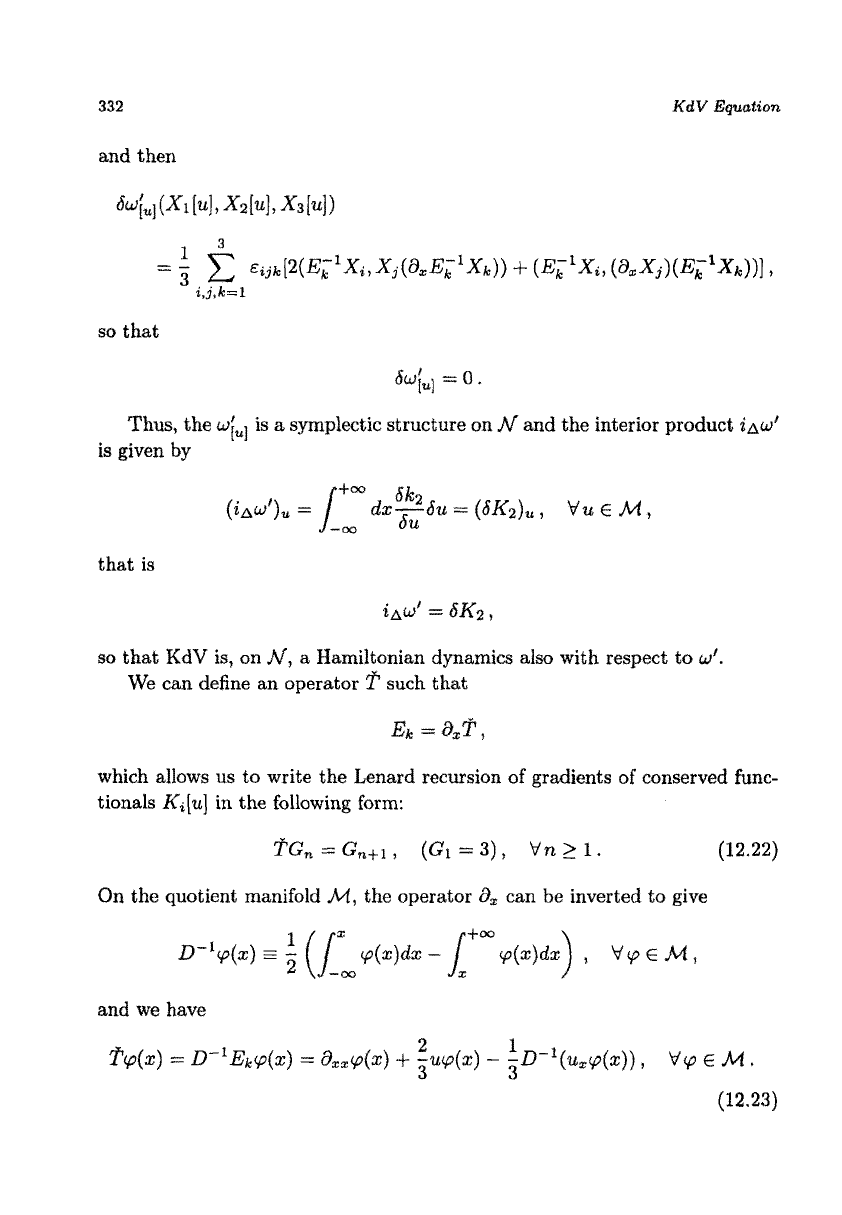
332
KdV
Equation
and then
so
that
swj,,
=
0.
Thus, the
wiU1
is
a
symplectic structure on
N
and the interior product
~AW'
is
given
by
that is
so
that
KdV
is,
on
N,
a Hamiltonian dynamics also with respect to
w'
We
can
define an operator
i"
such that
gk
=Z
&p,
which allows us
to
write the Lenard recursion of gradients
of
conserved func-
tionals
K,(u]
in the
following
form:
On
the quotient manifold
M,
the operator
ax
can
be
inverted
to
give
D-'P(x)
=
([L
cp(z:)dx
-
1'"
~(x)dx)
,
Vtp
E
M
,
X
and we have
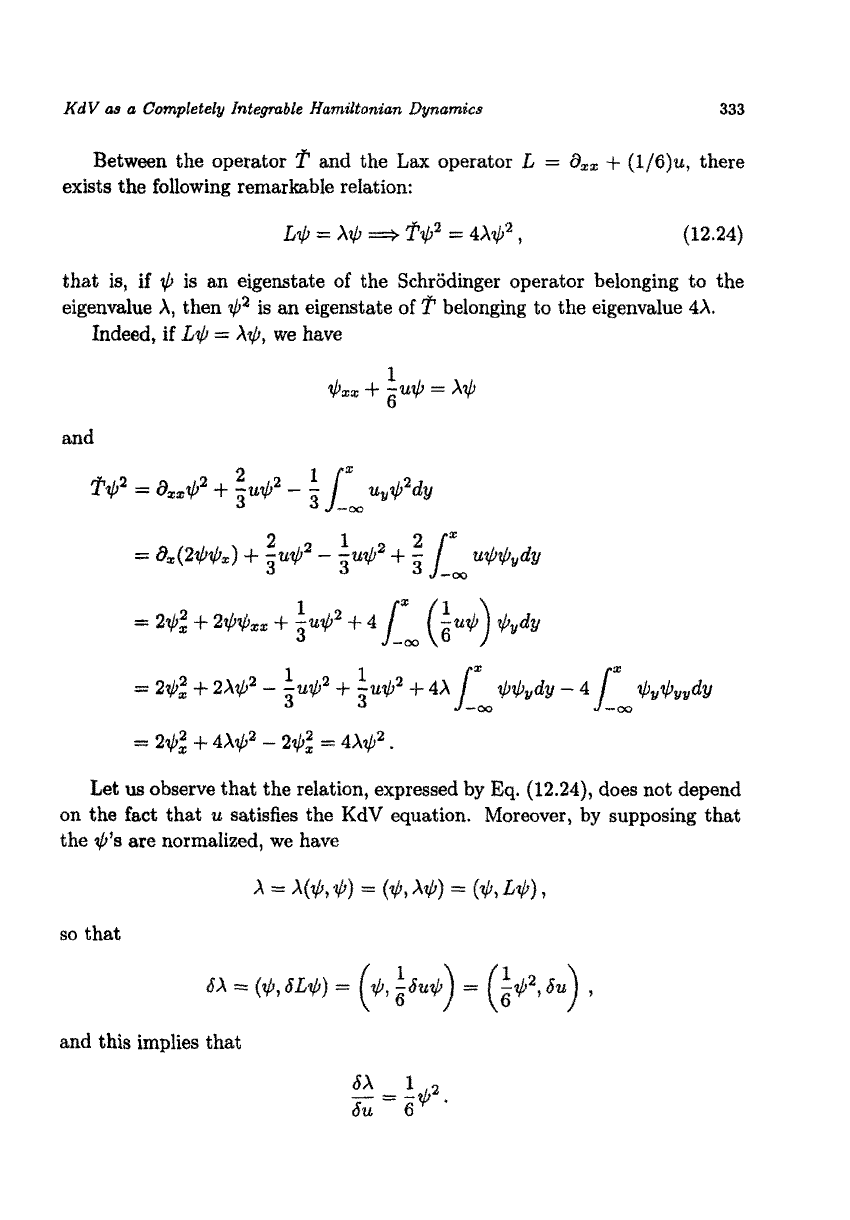
KdV
as
a
Completely
Integrable
Hamiltonian Rpamics
333
Between the operator
rf'
and the
Lax
operator
L
=
ax,
+
(1/6)u,
there
exists the following remarkabte reiation:
L$
=
A$
===$-
T$2
=
4Xzf12,
(12.24)
that
is,
if
eigenvalue
A,
then
$a
is
an
eigenstate
of
i"
belonging to the eigenvalue
4X.
is an eigenstate
of
the Schrodinger operator belonging to the
Indeed, if
L$
=
A$,
we have
1
$xx
+
-gu$
=
A$
and
1
1
=
29:
+
2X$2
-
-u$J'
+
p$2
+
4X
$$)ydy
-
4
Jx
$v$l.'%ratdy
3
L:
--oo
=
2$Z
+
4X$2
-
2$:
=
4Xzf12.
Let
us
observe that the relation, expressed by Eq.
(12.24),
does not depend
on the fact that
u
satisfies the KdV equation. Moreover, by supposing that
the
@'s
are normalized, we have
so
that
and this implies that
